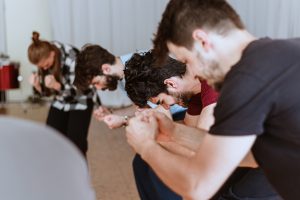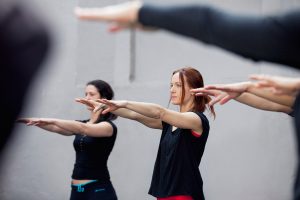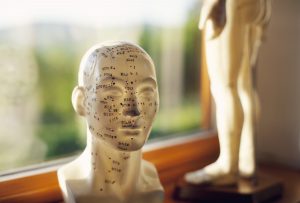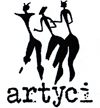 Written by Zuna Vesan_2016
Written by Zuna Vesan_2016
Translated by Žubra Žubretovská_2021
We have been integrating Qigong both into our teaching and our work as performative dance artists for several years. This fact is the result of our natural development and development of the needs of our bodies. Why?
Qigong is one of the ancient Chinese practices aiming at balancing body and mind. It is grounded on theory of the Traditional Chinese medicine (TCM). One of its main principles is the fact that a person is healthy if his or her energy (Qi) circulates through the body uninhibited, evenly and regularly. Qigong literally means “work with Qi energy“. Qi means energy, vital life force, thanks to which we are alive. One of its sources is gained from our parents, and during our lives we replenish it from secondary sources such as food, water and air. Qi circulates in our bodies in energetic pathways – called meridians, and it is also connected to our inner organs, which are nourished by Qi. Gong means activity, work, ability and also time and attention we spend on using our Qi. Thus, Qigong means the art of cultivation and mastering the vital life force Qi. It is a way how to secure its circulation throughout the body.
Qigong exercises are usually simple and done in slow pace. They improve our sense for Qi and its circulation throughout the body. They are the basis for martial arts and, at the same time, for the ability to heal. Qigong are sets of simple exercises, inspired by ancient Taoists, which have been gradually adjusted to a form accessible to broad public. Practicing these exercises leads to balancing Qi in the body, which is expressed by increased immunity, better hormonal stability, stability of lymphatic system, and overall balance and cooperation between inner organs. Qigong also helps to get rid of problems such as back pain, tiredness, stress or concentration and sleeping disorders. Qigong cultivates well-being, emotional stability and peace of mind. The main benefit for healthy people is that Qigong harmonizes human organism before an illness appears on physical level. The key in Qigong is our conscious work because the amount of Qi depends on our consciousness and ability to connect and concentrate inwards.
Why is Qigong part of our workshops and how do we use it?
We don’t compel students to memorize any complicated forms of Qigong (series of exercises). On the contrary, we use elementary and essential exercises focused on carrying out and sensing Qi in one’s own body rather than on the exact sequence. The exercises are very simple but extremely effective. They always focus on a specific body part, body centre or body structure, which are, afterwards, important in the dance training. We usually open my lessons with Qigong to wake up energy in dancers´ meridians, to activate their bodies, and prepare them for further work during the dance training or dance improvisation. However, Qigong in its essence, can be parallel to dance as a subconscious part of dance and movement expression, both during dance training or improvisation, or even during performance on stage. The physical effort during dancing usually leads to exhaustion. However, if the principles of Qigong are applied to dance, it, on the contrary, results in charging the body and soul.
Together with Milan we have created an open platform of our systematic and concentrated work in a field of interfacing dance and qigong. We named it „Dancing Qigong“. It is an intensive work by means of open seminars and researches, where dance becomes means of Qi cultivation and Qi materializes into a cultivated dance form through the medium of movement.
We have got several aims but one of the most important is to bring our students practical information about an appropriate preparation for dance performance, about improving their technique and enhancing their interpretative abilities as performers as well as providing deeper knowledge of healthy and effective body work, aiming to prolong their artistic career. The “Dancing Qigong” seminars are also sought after by amateurs, actors, ordinary people who like movement and want to learn about their healthy and energetic functioning.
 For the richness of the content and the complexity of the topic, we divide the seminars into different thematic areas. It is not necessary to attend all. These are, for example, the following topics:
For the richness of the content and the complexity of the topic, we divide the seminars into different thematic areas. It is not necessary to attend all. These are, for example, the following topics:
Embodied Yin-Yang – Yin-yang, the cosmic principles of a single Qi energy, allow by their rotation and interaction the birth and development of the world and everything in it. This principle also plays an important role in dancing. It is a part of kinetic, spatial or musical dynamics, but it also respects the natural disposition of the body and the possibilities of movement.
Meridian Flow is focused on the conscious work with the skeleton structure, enriched by the logic of the Qi energy flow in meridians. Activating energy in a certain meridian pathway can be an impulse to discover new movement possibilities and physical connections, as well as new qualities for movement or dance. These unusual body connections generate new links between the particular parts of the body.
The Flow of 5 elements is focused on working with yin-yang transformations and then with the flow of five energy transformations (5 elements) around us, but mainly in the movement of our own body. Each phase (element) also calls for a different way to use the body with the improvement of techniques, but also in improvisation or creation.
Body Awakeness is a space in which we can perceive, observe, and exercise by a conscious, vigilant mind. Such a mind has enough time to listen to the energy of the body, to recognize its feelings, and to use natural stimuli for free movement. Body Awakeness is a space where we can get to know the interface between western anatomy with energetical anatomy.
Living Spine is a concentrated dive into the depth of one of the most important parts of the body – spine throught its sceletal and energetical structure.
What are the other attributes of Qigong which can enrich our dance as well as personal life?
Originally, the aim of Qigong was not just health and stamina cultivation but, above all, it was self-knowledge, getting to know one’s own body and achieving its natural condition, a state of harmonious body-mind connection. Such Qigong, which leads to the cultivation of mental power, is known as “Inner Qigong” and it is a very important part of my work. We also use Qigong in my dance practice because it cultivates patience and persistence. It is not possible to expect immediate effects and especially not those which are visible on the first sight. Therefore, students learn both to be humble and to trust their bodies and its processes, as well as their own focus and ability to concentrate.
Another fascinating aspect of Qigong, which I use and offer to my students, is the principle of “not doing”, so called “wu-wei”. To put it simply, it means “letting nature take its course”. We try to achieve a peaceful state of mind when we don´t strive for success and perfection, we don´t make efforts to be better than others, etc. Such states of mind often block dancers to move naturally and can even lead to injuries. “Wu-wei” also teaches us not to get confused by various physical or mental states that may occur during exercises. Although we can feel discomfort, pain or, on the contrary, extreme pleasure, we learn not to cling to any sensations or feelings at all. We try to let the present moment flow freely, accepting anything it can bring along. Many our feelings are illusions anyway. Qigong can teach us letting go of these illusions. It is a long-term process, cultivating our persistence and modesty.
 Least but not last, Qigong can be an amazing way to help strengthen the body for dance. Practicing Qigong can strengthen bones, joints, tendons, muscles and inner organs, which, according to TCM, nourish those structures with beneficial Qi. For this purpose, we use various exercises, for example “breathing through bones”, breathing through kidneys”, “rubbing tendons”, etc. In fact, those exercises wake up new life in body structures which are nourished thanks to Qi circulation. Moreover, absorbing and recycling Qi strengthens the immune system and Qigong is a perfect means to expedite healing injuries as well.
Least but not last, Qigong can be an amazing way to help strengthen the body for dance. Practicing Qigong can strengthen bones, joints, tendons, muscles and inner organs, which, according to TCM, nourish those structures with beneficial Qi. For this purpose, we use various exercises, for example “breathing through bones”, breathing through kidneys”, “rubbing tendons”, etc. In fact, those exercises wake up new life in body structures which are nourished thanks to Qi circulation. Moreover, absorbing and recycling Qi strengthens the immune system and Qigong is a perfect means to expedite healing injuries as well.
Qigong also develops our ability to connect to our inner spirit. Conscious work with Qi is the basis of Qigong. We can use this skill to calm ourselves, tune us to current situation or our state, but also as a way of concentration before performance or before a difficult test. The power of calm mind together with focus on physical structures, can sometimes prepare body for performance more thoroughly than physical exercises themselves. I, myself, practice this art before performing.
Extract from the book Tao of movement.
Translation of this text is supported by Slovak Art Concil

